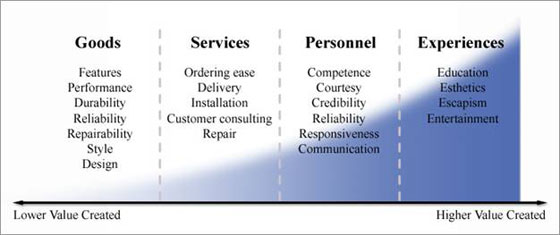


Page 3/10 |
“The real strengths of successful small independent businesses revolve around specialization, differentiation, and finding profitable, defendable, and sustainable niches.” (National Retail Federation, 2005) |
A differentiation strategy seeks to develop a competitive advantage and attract customers by positioning its offerings in a unique and distinctive way. It must be truly different in the eyes and mind of your customer. The element(s) upon which a firm positions itself must be something important to customers--it must be something they value. Once this is discovered, a small business can then begin to charge (maybe even a higher price) for this offering (Pine & Gilmore, 1999).
|
Retail |
Figure 2.1 reflects the continuum of elements a small firm can use to develop a unique combination of offerings and achieve differentiation in the marketplace (Kotler, 1997, p. 283). Note that experiences can complement the other offerings or could be the primary offering.

Figure 2.1
Adapted from: Kotler, P. (1997). Marketing Management: Analysis, Planning, Implimentation, and Control. Upper Saddle River, NK: Prentice Hall.
Pine, B.J., & Gilmore, J.H. (1999). The Experience Economy: Work is Theatre and Every Business a Stage. Boston, MA: Harvard Business School Press.
Page 3/10 |
Web site and all contents © Copyright SRDC 2009, All rights reserved. |
|
| These materials were developed as part of the Southern Rural Development Center’s National e-Commerce Extension Initiative. They are based upon work supported by the Cooperative State Research, Education, and Extension Service, U.S. Department of Agriculture, under Award No. 2005-45064-03212 Any opinions, findings, conclusions, or recommendations expressed in this publication are those of the author(s) and do not necessarily reflect the view of the U.S. Department of Agriculture or the Southern Rural Development Center. |
|
